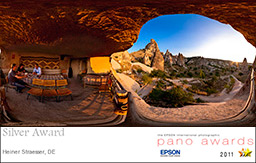» professional panorama photography «
On the following pages you will find more than 300 interactive panoramas. A large proportion of them are spherical panoramas, the perfect way to represent a room. The viewer is in the center and moves the space around him. There are also 360-degree panoramas and classical panoramic images with resolutions down to gigapixels.
inverted spherical panorama
an example from »specials«
With a panoramic image on your website, you achieve a significantly longer page viewing time. This gives you the ability to attract your customers' emotions. A crucial role is played by the quality of the panorama. Present yourself professionally, and your customer will be convinced of your product.
The project examples show a variety of different areas in which I successfully used panoramic images. Among the "Specials" you'll find a variety of unusual panoramic formats and a few specific images.
To request a panoramic image, simply send me an email.
I hope you enjoy watching!
Heiner Sträßer, February 2012

Atomium in Brussels
The Atomium is the modern landmark of the Belgian capital. Built on the occasion of the Expo 1958, this model of a molecule consisting of nine atoms symbolises the atomic age..
Today, Brussels is known primarily as the seat of the EU administration. Hardly any other European capital is better suited for this. With reference to human dignity, the mayors of the 19 Brussels municipalities as well as the police refused to bow to inhuman orders of the Nazi dictatorship.


























